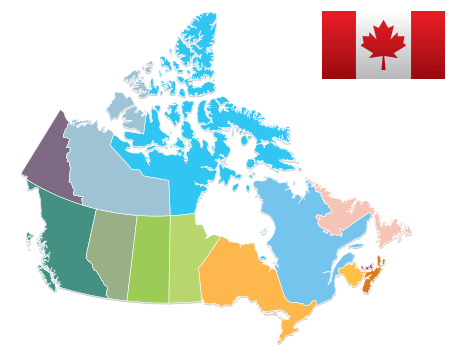Shale and Tight Resources in Canada
A product of the energy and mines ministers’ conference
Technological innovation and the increasing efficiency of horizontal drilling and multi-stage hydraulic fracturing technologies are unlocking vast unconventional shale and tight hydrocarbon resources in North America.
Shale and tight resources are unconventional because of the methods used in their extraction, and the types of reservoir from which they are produced. Both shale and tight resources are locked in geological formations with very low permeability Footnote 1 and usually require the combination of two technologies – horizontal drilling and hydraulic fracturing (sometimes referred to as “fracking”) to release the hydrocarbons and allow them to flow to the well at commercial rates.
Shale and tight resource development has transformed North American energy markets and provided significant economic opportunities, but at the same time is attracting public concern over its pace and environmental footprint.
About this portal
This web portal is a collaborative product prepared by federal, provincial and territorial governments. “Drill down”, by selecting a topic for more detailed information, or “drill laterally”, by selecting a province or territory, to learn more about shale and tight resource development in a particular jurisdiction.
Geography
There is significant potential for shale and tight resource development in various regions of Canada.
Shale and tight gas
Shale and tight gas resources are found in almost all provinces and territories. Most of the current production activities are occurring in the Montney formation in northeast British Columbia.
Principal shale and tight gas formations in Canada:
- Muskwa, Otter Park and Evie (Horn River Basin) (BC)
- Evie, Muskwa and Otter Park (Cordova Embayment) (BC)
- Muskwa and Besa River (Liard Basin) (BC and YT)
- Montney (BC and AB)
- Duvernay (AB)
- Kettle Point (ON)
- Utica (QC)
- Frederick Brook (NB)
- Horton Bluff (NS)
- Canol (YT)
Tight oil
Tight oil resources are found in British Columbia, Alberta, Saskatchewan, Manitoba, Quebec (Anticosti Island), Newfoundland and Labrador (western Newfoundland) and the Northwest Territories. Most of the current production activities are occurring in the Bakken, Viking and Cardium formations in Western Canada.
Principal tight oil formations in Canada:
- Bakken/Exshaw (BC, AB, SK and MB)
- Montney/Doig (BC and AB)
- Duvernay/Muskwa (AB)
- Cardium and Beaverhill Lake Group (AB)
- Viking (AB and SK)
- Lower Shaunavon (SK)
- Lower Amaranth (MB)
- Macasty (Anticosti) (QC)
- Green Point (NL)
- Canol (NT)
Geology
Shale and tight resources are hydrocarbons (crude oil, natural gas and natural gas liquids) found in tight reservoirs – rocks with pores so small or poorly connected that the oil and natural gas cannot flow through them easily. Hydrocarbons found in these types of reservoirs are referred to as “tight gas” or “tight oil”. Shale is a common type of tight reservoir that is composed of extremely fine-grained, sedimentary rock and may contain oil or natural gas – referred to as “shale oil” or “shale gas”.
Like all hydrocarbons, they formed over millions of years, when organic material (plants and micro-organisms) was buried and subjected to increasing heat and pressure and slowly transformed to oil and natural gas. Some of these hydrocarbons escaped into adjacent rock layers that are relatively easy to extract because of their reservoirs’ high porosityFootnote 2 and permeabilityFootnote 3. However, the majority remained locked in tighter, lower permeability layers where they could not be extracted through conventional means.
Shale and tight resources are essentially the same kind of oil and natural gas as their conventional counterparts. They are “unconventional” simply because of the methods used in their extraction, and the types of reservoir from which they are produced.
Geological characteristics
The ability of a reservoir to produce hydrocarbons is related to both its porosity and permeability.
Reservoir rocks are like sponges in that they hold oil and natural gas in cavities (pores) present naturally in rocks. The percentage of pore volume within the rock is called the reservoir’s porosity.
In conventional reservoirs, pore space can vary from fairly large, visible openings to microscopic pores, and generally comprises less than 30 percent of rock volume. In tight reservoirs, porosity is commonly less than 10 percent.
However, regardless of the total porosity volume, if these pores are not efficiently connected one to the other, oil and natural gas cannot move and be extracted. This plumbing system is known as permeability and is as important as the porosity for reservoirs. The higher the permeability, the greater the amount of fluid that can flow through the rock.
Permeability is commonly measured in a unit called millidarcies. Conventional reservoirs may have permeability in the range of tens to hundreds of millidarcies. Tight reservoirs usually have permeability from 0.1 to 0.001 millidarcies, and shale reservoirs are even less permeable – in the 0.001 to 0.0001 millidarcies range. As a result, the average permeability of tight and shale reservoirs is usually too small to allow commercial production unless unconventional extraction techniques (horizontal drilling and hydraulic fracturing) are used.
In conventional reservoirs, hydrocarbons move easily through the formation until they are trapped against an impermeable rock – referred to as a “seal” or “cap” rock. This leads to localized pools of oil and natural gas that can be accessed with a vertical well drilled directly into the reservoir.
In tight reservoirs, hydrocarbons are often found within the same rocks in which they were generated. Otherwise, hydrocarbons in tight reservoirs can be found in the pore spaces and natural fractures of any tight rocks into which they migrated. Shale and tight resources tend to be widely distributed over extensive areas rather than concentrated in specific locations.
Conventional, Tight, and Shale Gas and Oil
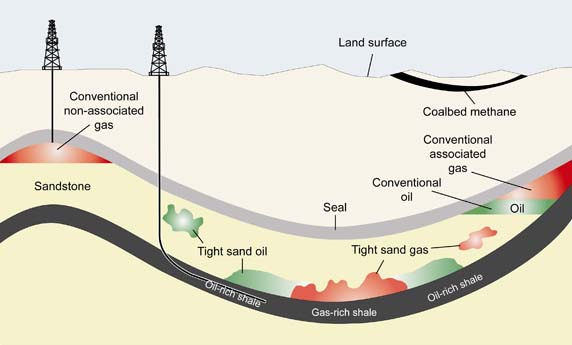
Source: National Energy Board (2011), Modified from Energy Information Administration and United States Geological Survey
Text Version - Figure 1
Figure 1: Diagram showing characteristic deposits of hydrocarbons resources below ground, including: conventional oil and gas, shale and tight oil and gas and coalbed methane.
Resource potential
Estimates of Canada’s shale and tight resources vary. Federal and provincial governments and regulators are in the process of developing a comprehensive and standardized approach to evaluate Canada’s shale and tight resources. Some industry claims of potential Canadian shale and tight resources still require independent verification by public geological assessments or commercial production.
Different types of estimates are used to measure the volume of available hydrocarbons. A key distinction is between “resources,” which may not yet be discovered or may not be economic to recover, and “reserves,” which are discovered by drilling and economic to recover. Estimates fluctuate due to changes in economic conditions, technology and available information. As more data become available, the accuracy of estimates will improve
The Canada Energy Regulator (CER, formerly the National Energy Board) estimates that Canada has 1,087 trillion cubic feet of remaining marketable gas resources, of which 750 trillion cubic feet is unconventional shale and tight gas. At the end of 2014, the CER estimated that Canada had approximately 171 billion barrels of remaining oil reserves, of which 97 percent is the oil sands and the rest is conventional and tight oil sources.
What are the different types of estimates of oil and gas resources?
- Oil/gas in place: The total volume of oil or natural gas that is contained within the reservoir. It does not indicate how much of that oil or natural gas is recoverable.
- Marketable oil/gas: Oil or natural gas that has been processed to remove impurities such as natural gas liquids and non-hydrocarbon by-products (e.g., CO2, H2S).
- Technically recoverable oil/gas: The volume of oil or natural gas that could be recovered from known reservoirs with current technology, regardless of economic conditions (e.g., prices, production costs).
- Economically recoverable oil/gas The volume of oil or natural gas that could be recovered from known reservoirs under foreseeable economic conditions (e.g., prices, production costs).
- Ultimate potential: The volume of proved reserves and technically recoverable marketable oil or gas inferred to exist from geological information but not yet discovered by drilling.
- Established reserves: The volume of technically and economically recoverable marketable oil or gas specifically proven by drilling, testing, or production, or estimated to exist with high certainty from geological or geophysical information.
Exploration and production
Technologies such as horizontal drilling and multi-stage hydraulic fracturing have enabled hydrocarbon production from shale and tight reservoirs that were previously uneconomic in North America.
Canadian production
Shale and tight resource production is growing, helping to offset declines in conventional production. In 2014, shale gas accounted for approximately 4 percent of total Canadian natural gas production while tight gas accounted for 47 percent. By 2035, the Canada Energy Regulator (CER, formerly the National Energy Board) expects tight and shale gas production together will represent 80 percent of Canada’s natural gas production.
In 2014, tight oil accounted for more than 10 percent of total Canadian crude oil production. By 2030, the CER projects moderate growth in light oil production from tight oil plays in the Western Canadian Sedimentary Basin (WCSB) as conventional heavy oil production declines. However, the development of tight oil reservoirs is still in early stages in Canada. The extent to which these resources can be produced from is largely undetermined.
Canadian Shale and Tight Gas Production
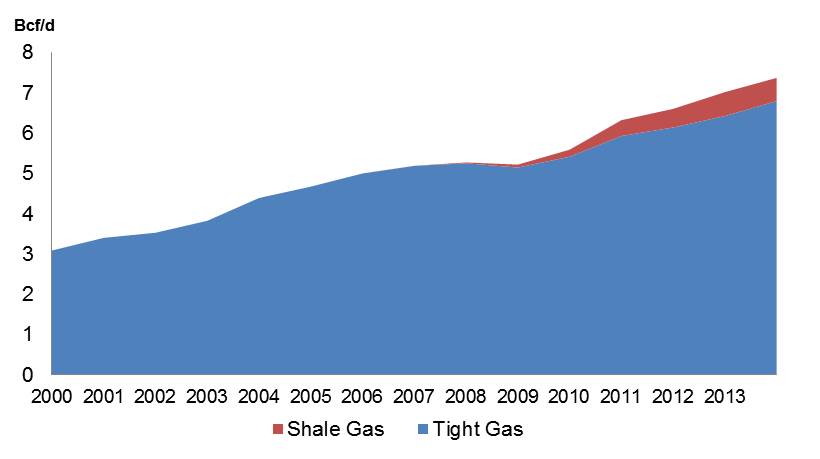
Text Version - Figure 2
Figure 2: Graph showing Canadian shale and tight gas production between 2000 and 2013. Production grew from three billion cubic feet per day in 2000 to seven billion cubic feet per day in 2013.
Canadian Tight Oil Production
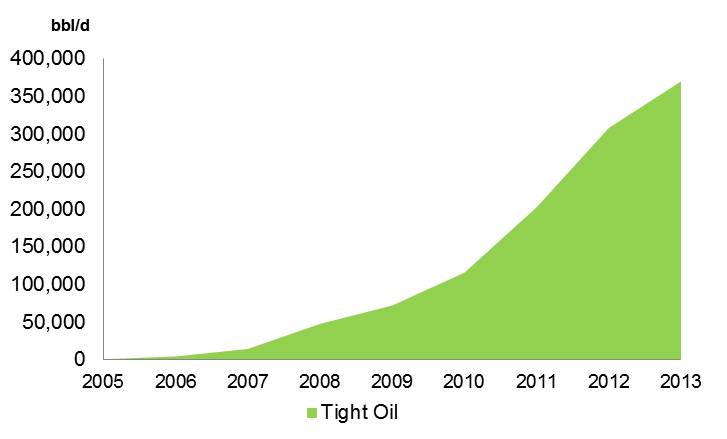
Text Version - Figure 3
Figure 3: Graph showing Canadian tight oil production between 2005 and 2013. Production grew from near zero in 2005 to 350,000 barrels per day by 2013.
Source: National Energy Board (2015)
In Canada, shale and tight production activities are located primarily in Western Canada, and exploration has been pursued in only a handful of provinces.
History
Over 500,000 oil and natural gas wells have been drilled in Canada since the first commercial oil well in North America was dug in Oil Springs, Ontario, in 1858, more than thirty years after the first commercial natural gas well was dug in Fredonia, New York, in 1821.
At Norman Wells in the Northwest Territories, oil was discovered in 1920 which flowed from naturally-fractured shale deposits connected to the underlying conventional oil pool.
In Alberta and Saskatchewan, natural gas has been produced from the Second White Speckled Shale for decades. In these early cases, there was typically sufficient natural fracturing to allow economic recovery using shallow, vertical wells.
The first Canadian tight gas production that resulted from horizontal drilling and multi-stage hydraulic fracturing came from the Montney Formation in British Columbia in 2005. The first modern Canadian shale gas production came from the Horn River Basin in 2006, also found in northeast British Columbia.
Interest in other Canadian shale and tight plays started around the same period in British Columbia, Alberta, New Brunswick, Nova Scotia and Quebec. From 2005 to 2008, higher oil prices gave companies the incentive to apply technologies used to produce shale and tight gas to tight oil formations in Western Canada.
Development process
The time required to develop shale and tight resources ranges from a few years to more than a decade.
Step 1: Exploration
Utica Shale
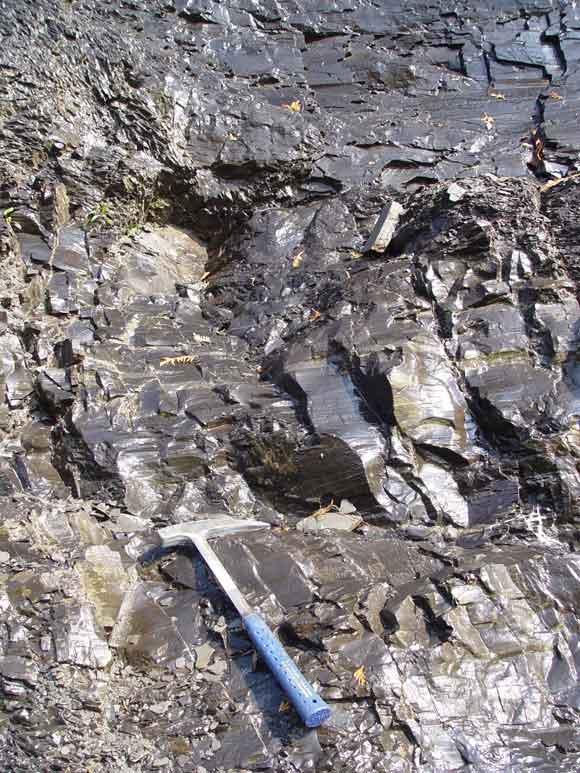
Source: National Energy Board (2009)
Text Version - Figure 4
Figure 4: Photo of Utica Shale near Montmorency Falls, Quebec. A hammer is shown for scale.
Before production, a producer must first assess the potential of a reservoir and begin the applicable regulatory process.
To prepare a site for exploratory drilling, a producer will take the following steps:
- Study the reservoir’s geology (e.g. geological assessment, seismic surveys)
- Lease mineral rights
- Apply for licences and permits
- Consult with landowners, other stakeholders and potentially affected First Nations
How does industry assess the potential of shale or tight reservoirs?
- Geological Assessment: Where a shale or tight formation is prospective for oil or natural gas that has formed and been trapped in place, the initial assessment would include a study of the formation's organic matter and thermal history to determine what kind of hydrocarbons (e.g., oil or gas) have been formed.
- The rocks would also be tested to measure the portion of hydrocarbons that are free in the pore spaces and the portion that are attached to the walls of any pore spaces.
- For any shale or tight formation, other assessments would include the thickness and geographic distribution of the formation, the mineral content of the rock, and the rock's physical properties (e.g., permeability, porosity, and brittleness).
- Seismic Survey: Seismic reflection profiles are used to characterize the geometric and volumetric parameters of sites, such as the depth and internal variations within a deposit. During a ground seismic survey, the reflection along rock planes of acoustic waves generated by vibrator trucks or small buried dynamite charges is recorded.
Step 2: Site preparation and well construction
Exploratory drilling is essential to determine a prospective rock formation’s physical and chemical characteristics and to assess the quality and quantity of the resource.
To prepare a site, a producer will take the following steps:
- Build the access road and construct the well pad
- Drill the initial hole (wellbore) to determine if the well looks promising
The hole is drilled in two or more stages, with at least a surface hole over shallow zones, sometimes an intermediate hole that is drilled from the bottom of the surface hole to somewhere above the top of the targeted formation, and a production hole that is drilled into the targeted formation.
As each stage is finished, a steel pipe is run along the length of the wellbore and cemented into place. This way, the shallow zone and the groundwater behind it is protected by at least two pairs of steel and cement barriers. As well, the well pressure is contained and the wellbore is stabilized. The rock section not being targeted can therefore be isolated from well operations while the targeted formation is being hydraulically fractured and later produced.
Step 3: Drilling
Horizontal Versus Vertical Wells
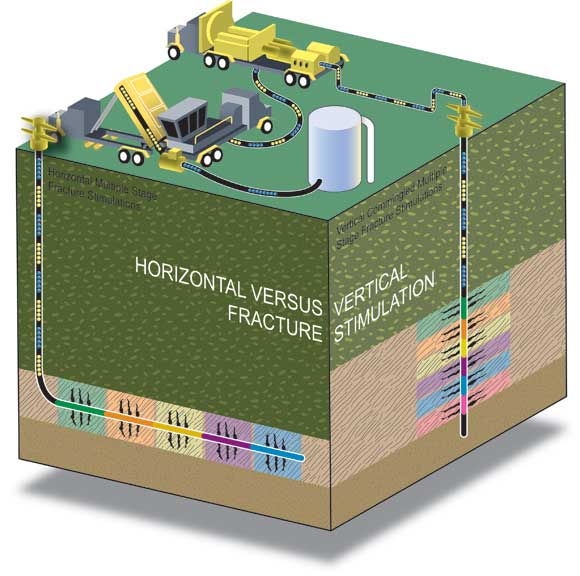
Source: JuneWarren-Nickle's Energy Group (2008)
Text Version - Figure 5
Figure 5: Schematic of a horizontal well and a vertical well using multi-stage hydraulic fracturing.
Vertical wells in shale and tight formations have difficulty producing at economic volumes because wells intersect only a limited amount of prospective rock. This limits how much oil and natural gas can be produced.
Horizontal drilling is a technique that involves initially drilling a vertical well from the surface and then progressively directing it horizontally through the target zone.
The horizontal leg of horizontal wells is drilled along one to three kilometres of prospective rock. Thus, while the costs of drilling a horizontal well are significantly higher than a vertical well, the increased production from the larger body of rock is more than enough to offset those extra costs. This makes the horizontal well economically successful where a vertical well might be an uneconomic.
Step 4: Stimulation
Microseismic Imaging
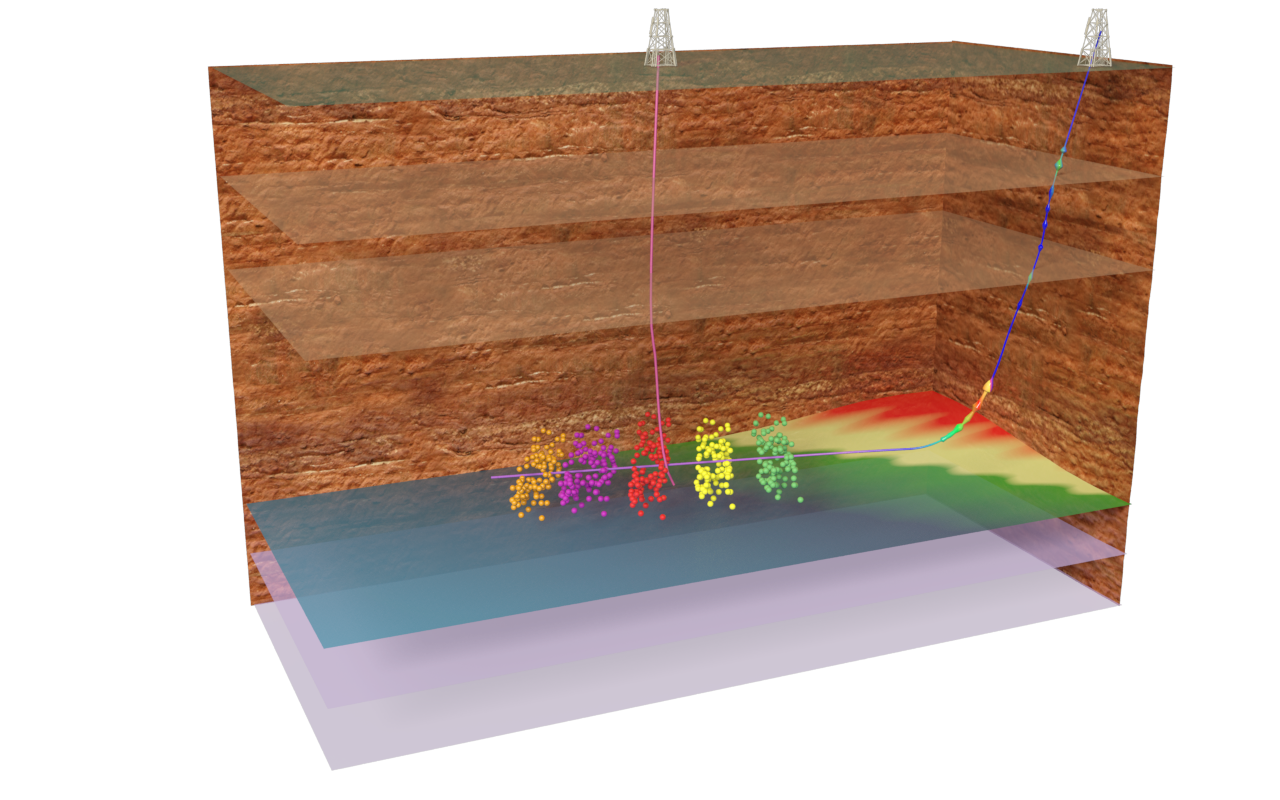
Text Version - Figure 6
Figure 6: Microseismic imaging of a horizontal well during hydraulic fracturing.
Even with horizontal drilling, most reservoir rocks containing shale and tight resources must be stimulated to enable the hydrocarbons to flow to the wellbore.
Hydraulic fracturing is a common stimulation technique, often referred to as “fracking” in industry jargon. The method involves the injection of pressurized water into the rock unit, usually mixed with a small volume of sand and chemical additives.
How does hydraulic fracturing work?
During hydraulic fracturing, water is injected into the rock unit under very high pressures until the rock cracks and fractures.
Sand (proppant) is added to the water and injected into the formation to prevent the artificially created fractures from closing. The fractures thus remain open and allow the oil or natural gas to flow to the well-bore.
Chemical additives (generally representing less than 1 percent of the fluid) are used for several purposes, mostly to increase viscosity, optimize post-fracturing water recovery or protect the production pipe casing from corrosion. The fracturing fluid used is specific to each operator and differs from one formation to another.
Industry generally targets formations located more than one kilometre deep, and hydraulic fracturing is only permitted below the deepest freshwater aquifers.
Step 5: Well operation and production
After hydrocarbons have been unlocked from the shale or tight reservoir and are able to flow to the wellbore, they are collected at the well head using methods similar to those for conventional oil and gas.
Once a well is in production, it commonly produces for 10 to 30 years. Producing wells are monitored and inspected for leaks.
Step 6: End of production and reclamation
When a well is no longer productive, it is abandoned and the land is reclaimed.
Before abandonment, the well must be properly sealed by the company. First the company cleans and inspects the inside of the wellbore, making any needed repairs.
Second porous formations and groundwater zones are isolated from each other and the wellbore with cement. The well is then filled with non-corrosive fluid. Finally, the company cuts the well casing below surface level and plugs the well by installing a vented cap.
Reclamation occurs over several years. To restore the land, the company must clean or remediate any contamination detected, remove foreign materials, restore soil profiles, replant native vegetation and landscape according to regulatory requirements.
Regulation
Under Canada’s Constitution, provinces own onshore energy resources within their borders and are the primary regulator of their development.
Provincial regulatory bodies are constantly updating their regulatory frameworks to reflect the changing nature of oil and natural gas extraction technologies, including shale and tight resource development. These frameworks help to ensure safe operation, protection of the environment and resource conservation.
International Energy Agency’s Golden Rules for a Golden Age of Gas, 2012
“The technology and the know-how already exist for unconventional gas to be produced in an environmentally acceptable way... The industry must win public confidence by demonstrating exemplary performance; governments must ensure that appropriate policies and regulatory regimes are in place.”
Source: International Energy Agency (2012)
Regulation of development
In Canada, exploration and production rights for oil and natural gas are generally obtained through a bidding process, with the exception of Quebec, where the system operates on a first-come, first-served basis (claims).
In Canada’s North and offshore, the rights issuance process is based on a single quantifiable bidding subject with rights going to the best bid.
Currently, to encourage remote exploration, the bidding criterion is the total amount of money that the bidder proposes to spend doing exploratory work on the parcel within a specified time period (work bid commitment).
In most of Canada, exploration licences include the right to search for hydrocarbons but do not give ownership of surface rights. Landowner consultation is required to conduct exploration activities. Aboriginal consultation is also required on decisions that may impact Aboriginal rights or title on their lands.
Provincial regulations for oil and gas development differ. Regulators may require licenses for wells or specific permits to conduct geophysical work, drill, complete, hydraulically fracture, modify or abandon a well.
Lease agreements are often needed for surface land access. Regulators may also require that regular drilling reports, geophysical log data, and well testing data be made public, depending on the well category.
Federal role
Federal responsibilities include interprovincial and international energy trade, cross-jurisdiction pipelines, pollution prevention, habitat protection, regulatory oversight of chemicals, as well as natural resource regulation in parts of the Canadian North, offshore marine areas and Aboriginal lands.
As the federal energy department, Natural Resources Canada (NRCan) provides expertise and policy leadership on shale and tight resources by analyzing energy markets; funding and performing scientific research; and consulting with industry, regulators, academia and other government departments to inform policy and address concerns.
The Geological Survey of Canada (GSC), within NRCan, provides geoscience information used in making exploration, resource management and environmental protection decisions.
Environment and Climate Change Canada and Health Canada
Environment and Climate Change Canada’s (ECCC) role and authorities in relation to pollution prevention and habitat protection is provided for in a number of statutes, in particular under the Canadian Environmental Protection Act, 1999 (CEPA 1999) and the Fisheries Act. ECCC also has responsibility for the Species at Risk Act and the Migratory Birds Convention Act.
Under CEPA 1999, Health Canada (HC) and ECCC share the responsibility for assessing potential risks associated with environmental pollutants and chemical substances and for developing control measures if a substance is proven to be a risk to the environment or the health of Canadians. This includes the authority to regulate listed air pollutants and greenhouse gases.
ECCC is also responsible for the administration and enforcement of the pollution prevention provisions of the Fisheries Act, which prohibit the deposit of deleterious substances in water frequented by fish or in a place where that substance may enter such water, unless the deposit is authorized by regulation under a federal act.
The Canada Energy Regulator (CER, formerly the National Energy Board) is an independent federal agency that regulates several aspects of Canada's shale and tight resource industry. It regulates the construction and operation of interprovincial and international pipelines and energy trade.
The CER also has regulatory responsibilities for oil and gas exploration and production activities in specific areas that are not regulated under joint federal/provincial accords. Regulatory responsibilities are under the Canada Oil and Gas Operations Act, and certain provisions of the Canada Petroleum Resources Act are administered to particular regions.
Lands where the CER has jurisdiction over oil and gas activities
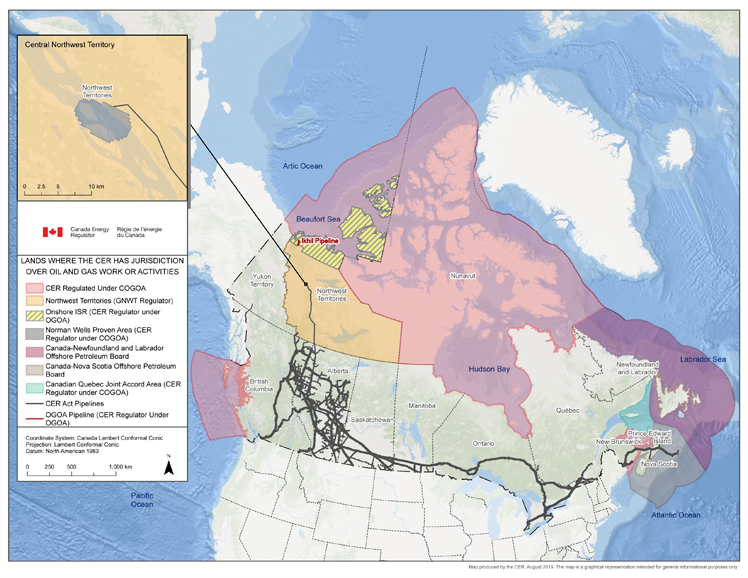
Source: Canada Energy Regulator (2019)
Text Version - Figure 7
Figure 7: Map of Canada showing areas where the CER has primary regulatory authority over oil and gas development. These areas include Nunavut, parts of the Northwest Territories and offshore areas of British Columbia, the Arctic and the East Coast that fall outside the jurisdiction of the Canada-Newfoundland and Labrador Offshore Petroleum Board and the Canada-Nova Scotia Offshore Petroleum Board.
Shale and tight resources on First Nation reserve lands are regulated by Indian Oil and Gas Canada (IOGC), a special operating agency within Indigenous Services Canada (ISC). IOGC operates pursuant to the Indian Oil and Gas Act and Indian Oil and Gas Regulations, 1995, as well as other relevant legislation and guidelines.
Environmental considerations
Opposition to shale and tight resource development usually centres on the potential impacts of hydraulic fracturing on public health and the environment.
Common environmental concerns relate to the potential impacts of development on surface water and groundwater sources, and air emissions. Potential land impacts including earthquakes (or induced seismicity) have also gained public attention.
In 2013, Environment Canada commissioned the Council of Canadian Academies to conduct a study on the state of knowledge of the environmental impacts associated with shale gas development in Canada. The report concluded that there are gaps in the scientific knowledge with respect to water resources and air emissions (both of which relate to well integrity), land, induced seismicity and societal impacts.
There is ongoing federal research to evaluate exploration or production techniques to prevent or minimize the risks of contamination, emissions, land impacts and induced seismicity associated with shale and tight resource development.
Water quality and quantity
The risk of surface and groundwater contamination from shale and tight resource exploration and production, and hydraulic fracturing in particular, is a common concern, particularly in populated areas where surface and groundwater is used as drinking water or for agricultural or industrial purposes.
Hydraulic fracturing has been used to stimulate production wells for conventional oil and natural gas reservoirs in North America for more than 60 years. Over 180,000 wells have been hydraulically fractured in Alberta alone (mostly vertical wells). About 14,000 horizontal wells have been hydraulically fractured so far across Canada, with most of them located in relatively remote areas. The majority involved relatively large, high volume fracture treatments.
Regulation of the oil and gas sector in Canada is designed to protect water resources during oil and gas development, including shale and tight development. Specific regulations vary between jurisdictions, but in all cases steel casing and cement are used to isolate and protect groundwater zones from deeper oil, natural gas and saline water zones.
Generally, all wastewater from hydraulic fracturing operations is collected and stored in enclosed tanks or impoundments with secondary containment to avoid potential soil infiltration. This wastewater can then be reused in other fracking operations or reinjected at depth in deep saline aquifers. Wastewater is not introduced into surface waters (e.g., lakes and streams) or into near surface aquifers used for potable water supply.
What chemicals are used in in hydraulic fracturing fluids?
During hydraulic fracturing, chemical additives (generally representing less than 1 percent of the fluid injected) are used for several purposes, mostly to increase the viscosity of the injected fluid, optimize post-fracturing water recovery or protect the production pipe casing from corrosion. The fracturing fluid used is specific to each operator and differs from one formation to another.
The chemical registry FracFocus.ca provides information related to additives used in hydraulic fracturing operations, methods of fracking and provincial regulations. Companies in British Columbia, Alberta and New Brunswick have a legal obligation to publicly disclose additives used in their fracturing fluids, and those regulated by the Canada Energy Regulator (formerly the National Energy Board) have a similar requirement.
Besides water quality issues, there is also public concern related to water quantity requirements for shale and tight resource development.
Not all unconventional reservoirs require large amounts of water and high pressure to frack. The quantity of water required to stimulate a well depends mainly on the geology and rock properties of the reservoir, which determine the pressure, depth, length, and method of stimulation necessary to fracture the rock.
While industry has historically used slickwater in hydraulic fracturing operations (a mix of water, sand and chemical additives), other techniques include using foams (a mix of gas and water), liquid propane, nitrogen, carbon dioxide, and combinations of these methods.
Air emissions
Another environmental concern related to shale and tight resource development relates to atmospheric emissions and air quality. Air contaminants, toxins and greenhouse gases can have impacts on population and ecosystem health on a regional scale, and on climate change on a global scale.
Most shale and tight gas plays currently being developed have low carbon dioxide content, similar to typical conventional gas production. Therefore, the greenhouse gas emissions per unit of shale and tight gas produced and consumed are similar to those from conventional natural gas production and use.
Does shale gas produce more greenhouse gas emissions than conventional gas? What about coal or petroleum products?
Lifecycle analysis considers all significant greenhouse gas emissions from all stages of production, processing, transportation and end-use of a fuel to provide a complete carbon footprint. Natural Resources Canada’s GHGenius lifecycle analysis tool was used to model the greenhouse gas emissions of shale gas.
Overall, this research found that shale gas had slightly higher emissions than conventional natural gas (4 percent higher) but had much lower emissions (29 percent to 38 percent lower) than petroleum products or coal.
Whenever natural gas is produced and cannot be marketed or re-injected into an oil or gas well, it must be either vented or flared.
Some studies assert that large volumes of methane, a potent greenhouse gas that is the main component of natural gas, are vented to the atmosphere during shale or tight well construction. This is rare in Canada due to environmental, economic and safety considerations. Most provinces that have significant natural gas production also have initiatives to reduce venting and flaring of gas.
Environment and Climate Change Canada’s greenhouse gas reporting program is for large facilities only. Hydraulic fracturing activities do not meet the threshold for reporting emissions, and most emission sources would occur at facilities not subject to reporting.
While provincial regulators set requirements and regulations for greenhouse gas emissions, these do not typically include small sources.
Methane leakage from wellbores has also been identified as a potential cause for atmospheric contamination (fugitive emissions) from both conventional and unconventional wells. In Western Canada, provincial monitoring requirements enable regulators to quantify fugitive emissions that come directly from the well.
Land impacts
Common concerns related to potential land impacts of shale and tight development are footprint and induced seismicity.
The land-use footprint of shale and tight development is not expected to be much more than the footprint of conventional operations. Advances in horizontal drilling technology allow for many wells to be drilled and produced from the same site. With the use of well pads, where multiple horizontal wells are drilled from the same location, fewer access roads are required and the concentration of facilities and pipelines within the footprint further minimizes surface disturbance.
Most natural earthquakes in Canada occur in active seismic zones where hydraulic fracturing or deep-well wastewater injection is not taking place.
While hydraulic fracturing or deep wastewater injection can sometimes be linked to the occurrence of felt earthquakes, these events are usually relatively minor and rarely felt.
How does Natural Resources Canada monitor earthquakes and study induced seismicity?
Across Canada, there are more than 200 seismographs continuously recording local and global earthquake activity. Dense arrays of seismographs have been installed locally in several areas with hydraulic fracturing operations (e.g., northeast British Columbia) to decipher the source of tremors and to understand the rock reaction to hydraulic fracturing parameters.
In the case of areas with shale and tight reservoir development, the issue is to distinguish deep crustal events from shallow events linked either to fracking programs or to wastewater reinjection in deep aquifers.
Arrays of seismographs have also been deployed in the Northwest Territories and New Brunswick in areas of potential shale and tight reservoir exploration and development to monitor the regions’ natural seismicity as a baseline.
Economic implications
The development of shale and tight resources has the potential to make significant contributions to the Canadian economy. Benefits include jobs for Canadians, lease and royalty payments to the provincial or territorial governments that own the resources, and tax payments to municipal, provincial, territorial, and federal governments.
Macroeconomic implications also include increased investment, a stronger trade balance, and reduced dependence on imported energy.
Canadian economy
In 2014, the oil and gas industry represented 7.8 percent of Canada’s nominal GDP and supported over 190,000 direct jobs and over 170,000 construction jobs. The industry also accounted for $83 billion, or 31 percent, of total Canadian capital expenditures and $137 billion in domestic exports.
Federal, provincial, territorial and municipal governments receive direct revenues from energy industries in the form of corporate income taxes, indirect taxes, crown royalties and crown land sales.
Government revenue associated with oil and gas production is used for meeting government priorities, such as increasing tax revenue, reducing the deficit, supporting infrastructure projects and delivering a variety of programs and services to the public.
Between 2009 and 2013, government revenues from the oil and gas industry averaged $21.9 billion.
Natural gas prices
Natural Gas Prices (AECO)Footnote 4
($CAD/MMBtu)

Text Version - Figure 8
Figure 8: Line graph showing the decline in natural gas prices between 2003 and 2014 and average prices for each year.
Since 2008, rapid growth in U.S. shale gas production has contributed to a significant oversupply in the North American natural gas market. As a result, average natural gas prices in Canada have declined by nearly 71%, reaching record lows in December 2015
While Canadian natural prices have averaged around $4.60 per gigajoule over the past decade, prices in Europe and Asia have averaged around $10 per gigajoule.
Due to low natural gas prices, to remain competitive, Canadian producers are increasingly targeting natural gas deposits that are rich in natural gas liquids (e.g., ethane, propane, butanes and pentanes). Prices for these natural gas liquids are linked to oil prices and therefore sell at a higher price than natural gas.However, recently, growth in natural gas liquids production has created a supply glut in Canada and the U.S. and this oversaturated market is also leading to lower natural gas liquids prices.
Low natural gas prices have positive implications for Canadian consumers – be they in households, businesses, or industry.
In Canada, natural gas is used by residential and commercial users as a fuel for space heating, water heating, clothes drying, and cooking. Close to 50 percent of space heating and 67 percent of water heating in Canadian homes is fueled by natural gas. The decline in natural gas prices post-shale/tight revolution has yielded annual space heating savings of more than $300 per household.
Low natural gas prices have encouraged utilities to invest in gas-fired electricity generation, and are beneficial for energy-intensive businesses and industries that use natural gas as feedstock and fuel, such as the oil sands, or facilities that produce chemicals, fertilizer, pharmaceuticals and plastics.
Energy trade
Canada’s exports of oil and natural gas are coming under significant pressure from increasing marketable shale and tight production in the U.S., by far our largest energy customer. Demand for both imported oil and natural gas in the U.S. has declined since the mid-2000s.
By 2017, the U.S. could be a net exporter of natural gas and be producing as much as 10.6 million barrels of crude oil per day by 2020. This development, combined with limitations in existing pipeline infrastructure, has led to Canadian production consequently being under pressure to find alternative markets through the construction of pipelines and the development of liquefied natural gas (LNG) export terminals in Canada.
Find out more
Research
Natural Resources Canada research
As Canada’s federal geomatics and geoscience organization, Natural Resources Canada (NRCan) provides public geoscientific and geospatial expertise, knowledge and technology to strengthen Canada’s understanding, stewardship and sovereignty of its landmass and natural resources. GEOSCAN is the bibliographic database for NRCan scientific publications in earth sciences and features over 60,000 records.
NRCan has offices and labs dedicated to clean energy research, development, demonstration and deployment, and works with its partners to promote the sustainable and economic development of our natural resources while improving the quality of life of Canadians.
Through the Program of Energy Research and Development (PERD) and the ecoENERGY Innovation Initiative (ecoEII), NRCan also funds research and development by other federal departments, academics, individuals and companies to increase oil and gas recoveries from unconventional formations, lower their environmental footprints and increase environmental monitoring.
Collaborative research
The Responsible Shale Development: Enhancing the Knowledge Base on Shale Oil and Gas in Canada (PDF, 1.6 MB) report and its accompanying compendium (PDF, 1.5 MB), prepared for the 2013 Energy and Mines’ Ministers Conference (EMMC), compile and summarize all the major efforts and research that federal, provincial and territorial governments have undertaken on shale resource innovation and development.
As part of EMMC 2015, the Taking Action: Moving Forward Together on Energy Research, Technology and Innovation (PDF, 2.8 MB) report outlines the case for innovation through collaboration within the energy sector and presents an action plan that identifies shared priorities and proposes specific collaborative actions to improve environmental performance in shale resource development.
A new initiative, the Energy Geoscience and Geo-Engineering-Collaborative Open Innovation Network (EG-COIN), is in development to address shared research priorities of government, academia and industry for shale resource development.
These shared research priorities are as follows:
- Environmental issues
- Geo-engineering and extraction
- Reservoir characterization and resource assessment
Find out more
Page details
- Date modified:
